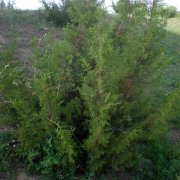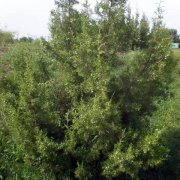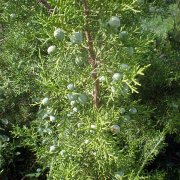Care of the shrub Juniperus californica or California juniper |
|
The Juniperus genus, Cupressaceae family, comprises 60 species of shrubs and trees native to the Northern Hemisphere. Some species are: Juniperus californica, Juniperus oxycedrus, Juniperus communis, Juniperus osteosperma, Juniperus phoenicea, Juniperus horizontalis, Juniperus squamata, Juniperus chinensis, Juniperus drupacea, Juniperus thurifera, Juniperus x pfitzeriana (hybrid), Juniperus brevifolia, Juniperus conferta. Common name: California juniper. This species is native to southwestern North America. They are dioecious evergreen shrubs or trees that reach 10 meters (32.8 feet) in height. Their growth is slow and they have leaves up to 5 mm (0.19") long arranged in opposite pairs or whorls of three. They produce berry-like female cones with a waxy white flower and male cones up to 4 mm (0.15") in length. They bloom in spring. California juniper is used for bonsai, as isolated specimens, in groups in dry areas of the garden, on rockeries and on slopes. Juniperus californica needs full sun exposure and a hot, dry climate (Mediterranean climate). It resists occasional frosts. They can grow in any type of soil that has good drainage. Water moderately waiting until the substrate has completely dried. Juniperus californica resists drought very well. California juniper does not need fertilizers or pruning. Juniperus californica is a plant resistant to pests and diseases but sensitive to excess humidity. California juniper propagates from seeds sown in autumn. Plant a lot of seeds because the germination rate is low. |
Images of the shrub Juniperus californica or California juniper |
Find plants
Juniperus californica or California juniper | Care and Growing
© 2025 FavThemes



